| |
|
Welcome to my
Flatpicking & Bluegrass Guitar
Lessons. I am going to cover the following
topics:
Good Practice Habits. *
Basic Bluegrass Guitar
Rhythm. *
Nashville Number
Charts.
"CAGED" Flatpicking for
Bluegrass Guitar * Bluegrass
Guitar Chords
Here is a link to
the materials I hand out at my Bluegrass and
Flatpicking Workshop
Click Here
|
| |
|
|
| |
1.
|
Solid Practice Plan
|
| |
|
Use a metronome.
This is the only way. Start Slow, Play Fast, using a
metronome makes the best use of your time. I use the
following Free Online Metronome at Best Metronome.
Click Here for the one I use
|
| |
|
Practice Tips
| * |
Practice Smartly. Locate problem areas and work
them over and over. Its not unusual to practice a
phrase 20 or 30 times. You need to build brain and
muscle memory into your hands. Repetition is the
only way. |
|
* |
Record yourself and listen. |
|
* |
Play Slowly and cleanly until you
have not only the notes but a solid groove. |
|
* |
Play fast. Even though it will not
sound great at first, don't worry, eventually your
brain and hands will get in sync and things will
start flowing. If you dont work on it, speed will
never happen. No one ever got fast by playing slow. |
|
* |
Practice Relaxed. Stiff arms and
shoulder will equate to sore arms and muscles and
your playing will not flow. |
|
* |
Sing your notes in your head.
Sing/hum the scale tones or solo notes as you play
them. Let your inner ear hear it. |
|
* |
Set a schedule for your practice.
Try to practice same time every day but if you
cant, find an hour a day at least. Set
expectations and goals. |
|
* |
Use good posture. Wear a strap. If
you plan to perform, practice standing up. Big
difference between sitting in the chair and
standing on the floor. |
|
* |
Loosen up a bit before you begin. Stretch your
arms, fingers and hands. Relax. |
|
* |
Have Fun! |
|
| |
|
*
|
| |
2. |
Bluegrass Guitar Rhythm
|
| |
|
Standard Boom Chick Pattern for G C
D |
| |
|

For Tabs for this rhythm pattern Click Here
For a Video of this rhythm patter Click Here |
| |
|
|
| |
|
Standard Boom Chick Pattern for G C
D with some passing tones
For Tabs for this rhythm pattern Click Here
For a Video of this rhythm patter Click Here |
| |
|
|
| |
|
|
| |
3 |
Nashville
Numbering System.
In this system, the scale tones are refered to as
numbers instead of the note name.
For instance, Lets look at the G scale
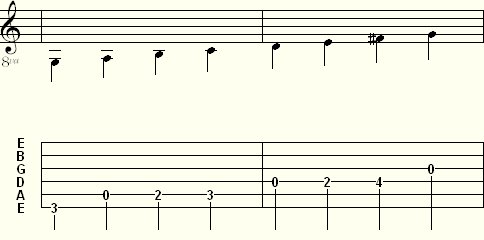
Here are three ways the G Scale can be
communicated.
|
Music Notes |
G |
A |
B |
C |
D |
E |
F# |
G |
|
Solfège Syllable
|
Do |
Re |
Mi |
Fa |
So |
La |
Ti |
Do |
|
Nashville Numbers |
1 |
2 |
3 |
4 |
5 |
6 |
7 |
8 |
Below is the Nashville Number System applied across different keys
|
KEY |
2 |
3 |
4 |
5 |
6 |
7 |
8 |
9 |
|
C |
D |
E |
F |
G |
A |
B |
C |
D |
|
D |
E |
F# |
G |
A |
B |
C# |
D |
E |
|
E |
F# |
G# |
A |
B |
C# |
D# |
E |
F# |
|
F |
G |
A |
Bb |
C |
D |
E |
F |
G |
|
G |
A |
B |
C |
D |
E |
F# |
G |
A |
|
A |
B |
C# |
D |
E |
F# |
G# |
A |
B |
|
B |
C# |
D# |
E |
F# |
G# |
A# |
B |
C# |
|
| |
|
|
| |
|
|
| |
|
CAGED
Flatpicking & Bluegrass Guitar
|
| |
|
I use the CAGED system for
understanding where the notes are and
to quickly find your
way around the fret board and create create guitar
solos. |
| |
|
|
| |
|
The "CAGED" system and its related chords.
This system refers to the 5 major chord shapes for
C, A, G, E and D
A guitar tuned to standard tuning
can be covered by five major chord shapes, These
are the
only major chords that can be played in an open
position.
F is just an E shape barred at the
1st fret and B is just an A shape barred at the
2nd.
So let’s have a look at the major chords of C,
A, G, E and D.
CAGED
Major Chords
Here’s how to think about the fretboard notes to
line up those chords.
First you will see the Major Open Chord shapes we
are most familiar with. The square notes are the
root notes of
each chord. It’s important that you learn these so
that you don’t need to think about them.
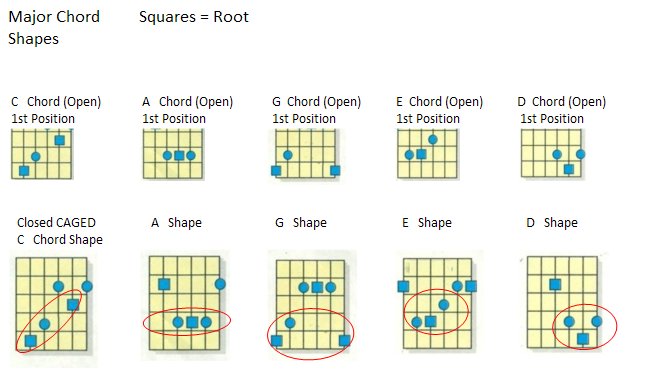
|
| |
|
|
| |
|
|
| |
|
Now look at the caged chords
and look across the page and see how it is applied
to a major
scale and a Major Pentatonic Scale
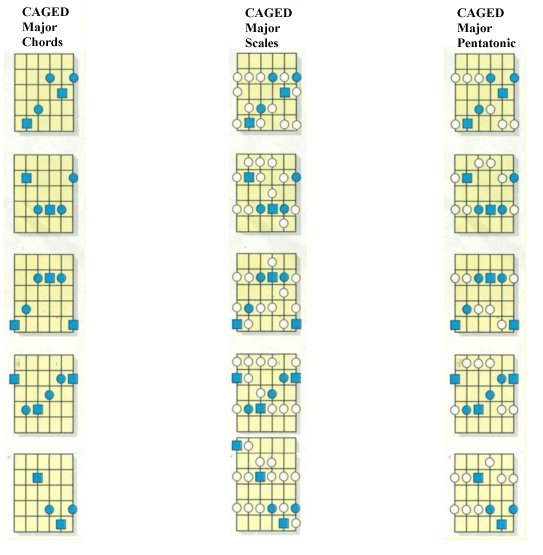 |
| |
|
|
| |
|
In this image, I have taken
all CAGED
Chords and merged them into one neck
view and added Nashville Numbers |
Here is
standard country pattern
1 with roots notes in blue |
Here is standard country pattern
2 with roots notes in blue |
 |
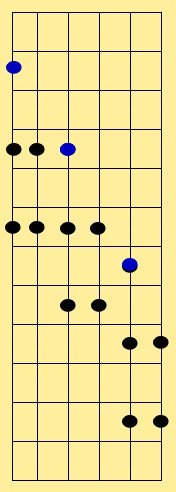 |
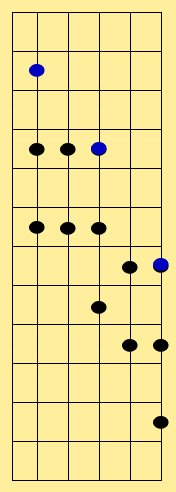 |
|
| |
|
|
| |
|
|
| |
|
|
| |
|
CAGED
Minor Chords |
| |
|
|
| |
|
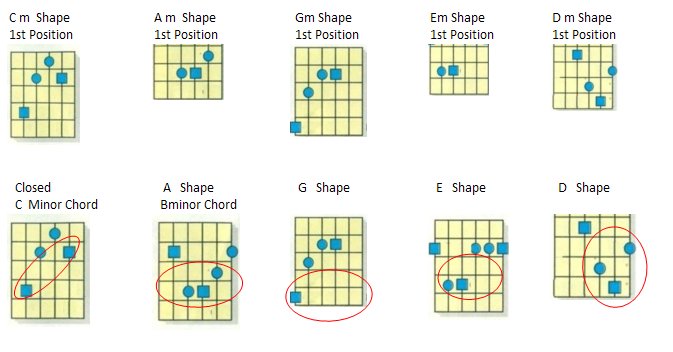 |
| |
|
|
| |
|
|
| |
|
Now look at the CAGED minor chords and
look across the page and see
how it is applied to
a minor scale and a minor pentatonic scale |
| |
|
|
| |
|
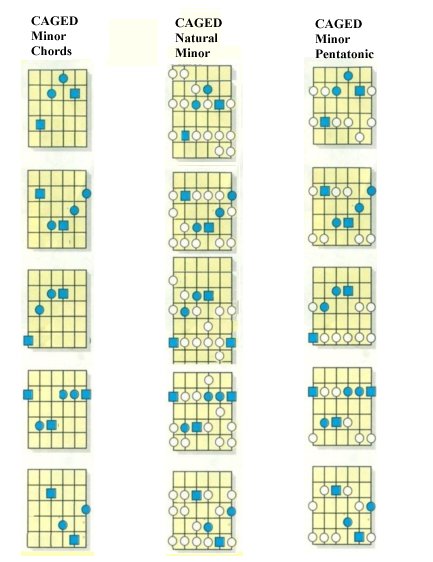 |
| |
|
|
| |
|
|
| |
|
CAGED
Minor Pentatonic
Blues Scales
On the left is the standard
presentation of the Minor Pentatonic Scale with
the "Blues" notes added in
On the right is CAGED minor pentatonic. Root notes
are square. Blues notes are blue. |
| |
|
|
| |
|
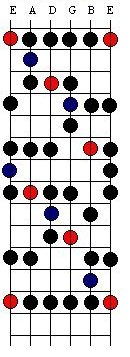
 |
| |
|
|
| |
|
Basic Open Chords |
| |
|
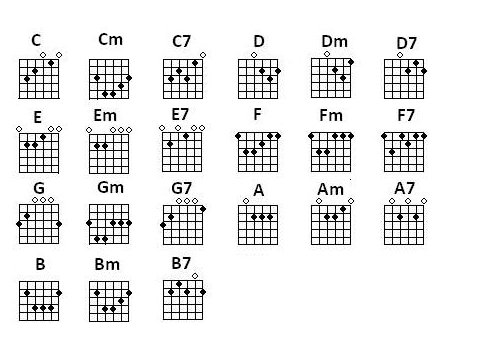 |
| |
|
|
| |
|
|
| |
|
Additional Chord
Structures |
| |
|
|
| |
|
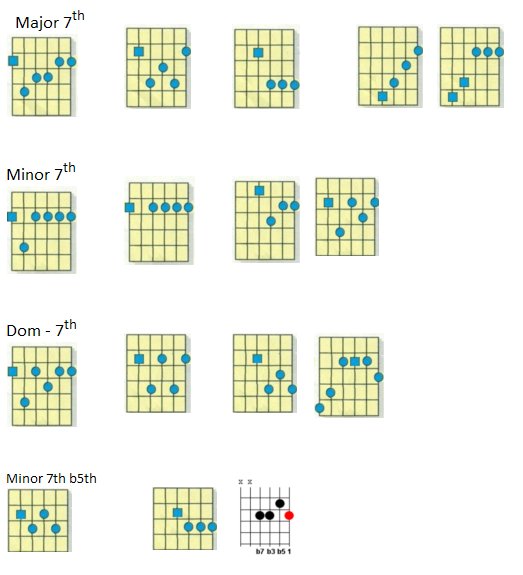
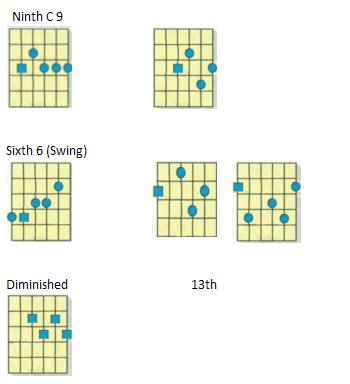
|
| |
|
|
| |
|
|
| |
| |
| |
| |
|
|
| |
|
|
| |
|
|
| |
|
Below is a chord chart for the 7
most used keys. To create a progression, simply
follow a chord progression formula
(I is always
the key of the progression). For example, a very
popular chord progression formula is I-IV-V, in
the key
of C, the chord progression would be
C/F/G, in the key of G the progression would be
G/C/D.
Another extremely popular chord
progression, is the I/V/vi/IV
(one-five-six-four). In C the chords would be
C/G/Am/F and in G it would be G/D/Em/C.
|
I |
ii |
iii |
IV |
V |
vi |
vii |
|
Major |
Minor |
Minor |
Major |
Major |
Minor |
Dim |
|
A |
B |
C# |
D |
E |
F# |
G# |
|
B |
C# |
D# |
E |
F# |
G# |
A# |
|
C |
D |
E |
F |
G |
A |
B |
|
D |
E |
F# |
G |
A |
B |
C# |
|
E |
F# |
G# |
A |
B |
C# |
D# |
|
F |
G |
A |
Bb |
C |
D |
E |
|
G |
A |
B |
C |
D |
E |
F# |
|
| |
|
|
| |
|
 |
| |
|
|
| |
|
|
| |
|
|